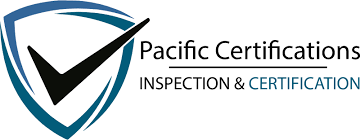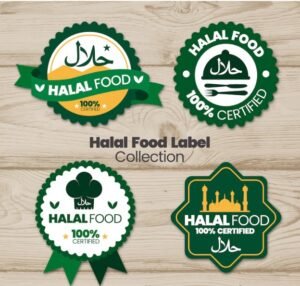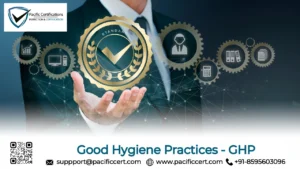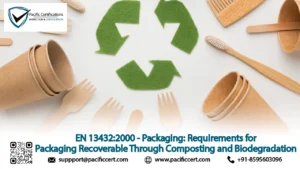What is ISO 8100?

ISO 8100-20 sets out the design rules as well as safety parameters and installation requirements for lifts that transport both passengers and goods. This standard works alongside ISO 8100-1 and focuses on ensuring lifts are designed and constructed in a way that delivers consistent performance with user safety and accessibility. It defines the technical specifications for lift components and operation to meet the needs of a wide range of buildings from commercial complexes to residential towers and industrial facilities.
Lifts are an integral part of modern infrastructure and as buildings grow taller and more complex, safety, comfort and accessibility become more important. ISO 8100-20 establishes a unified reference for lift design for ensuring that manufacturers and building owners work to a common benchmark that prioritizes safe and efficient vertical transportation.
To begin your ISO 8100-20 certification process or to speak with our audit team, reach out at support@pacificcert.com
What is the purpose of ISO 8100-20?
The primary aim of ISO 8100-20 is to provide detailed technical requirements for the design and installation of lifts that carry both passengers and goods. This standard supports safe and consistent lift performance by defining the dimensional, safety, and accessibility parameters that manufacturers and installers must follow.

While ISO 8100-1 outlines general lift safety rules, ISO 8100-20 focuses on the specific design aspects that influence space allocation, door configuration, and operational suitability. It ensures that lifts are built to serve their intended use efficiently while maintaining safety, comfort, and accessibility for all users. The purpose also extends to creating uniformity in lift construction, making it easier for building planners, contractors, and owners to specify compliant systems in new or refurbished projects.
Scope and Applicability
ISO 8100-20 applies to permanently installed electric lifts intended for the transport of passengers, goods, or both, moving between predefined landing levels in a building. It covers lifts operating inside a lift well with cars that move vertically or at an inclination of less than 15 degrees to the vertical. The standard applies to passenger lifts, goods-passenger lifts, and service lifts in commercial, residential, industrial, and public buildings. It sets parameters for car and door dimensions, shaft space, pit and headroom requirements, and accessibility features to ensure the lift is suitable for its intended use. The scope does not extend to escalators, moving walks, or temporary lifting devices, nor does it replace local building codes, but it provides an international benchmark that can be integrated into national regulations.
Clause-wise Structure of ISO 8100-20:2018
Clause | Title | Description |
1 | Scope | Defines where and how ISO 8100-20 is applied, covering lifts for the transport of persons and goods with details on applicable types and installations. |
2 | Normative References | Lists other standards that must be referred to alongside ISO 8100-20 for complete compliance. |
3 | Terms and Definitions | Clarifies lift-specific terms such as rated load, car dimensions, landing door, and accessibility features. |
4 | General Requirements | Sets the base parameters for design, performance, and installation for lifts carrying both passengers and goods. |
5 | Dimensional Requirements | Specifies car sizes, door openings, shaft dimensions, and pit/headroom clearances. |
6 | Safety Provisions | Details mandatory safety measures, including door interlocks, emergency communications, and over-speed protection. |
7 | Accessibility Features | Covers requirements for universal access, including control panel positioning, tactile indicators, and audible signals. |
8 | Testing and Verification | Outlines procedures for verifying compliance, including ride quality, leveling accuracy, and safety system tests. |
9 | Marking and Documentation | Specifies the information that must be supplied to building owners, users, and maintenance providers. |
What are the requirements of ISO 8100-20:2018 Certification?
Before seeking certification, lift manufacturers and installers must ensure that their products meet the detailed technical and safety requirements outlined in ISO 8100-20. These requirements apply to the design, manufacture, and installation phases. Below are the key requirements:
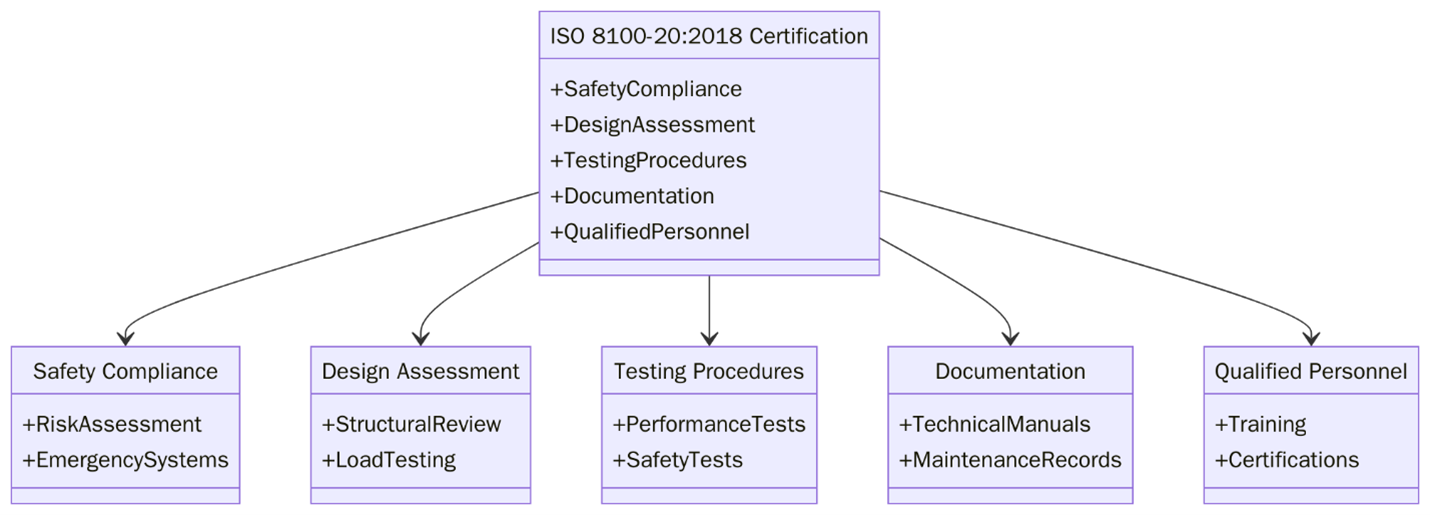
- Lift dimensions, load capacities, and door sizes must be within the defined tolerances for passenger and goods transport as specified by the standard.
- Safety clearances in the lift shaft, pit, and headroom must be maintained to prevent accidents during operation or maintenance.
- Control systems must be designed to handle emergency stops, door interlocks, and fail-safe mechanisms without compromising passenger safety.
- Lift doors, car walls, and flooring materials must meet strength and durability standards to withstand daily wear.
- All electrical systems must comply with relevant wiring and grounding rules to avoid electrical hazards.
- Accessibility features, such as control panel height and braille indicators, must be incorporated for compliance with universal design principles.
- Testing must confirm the lift’s smooth ride quality, leveling accuracy, and noise control within acceptable limits.
- Documentation must include design drawings, maintenance instructions, and testing reports to support the certification audit.
What are the benefits of ISO 8100-20:2018 Certification?
Adopting ISO 8100-20 offers a range of benefits for manufacturers, building owners, and users. Below are some of the key benefits:
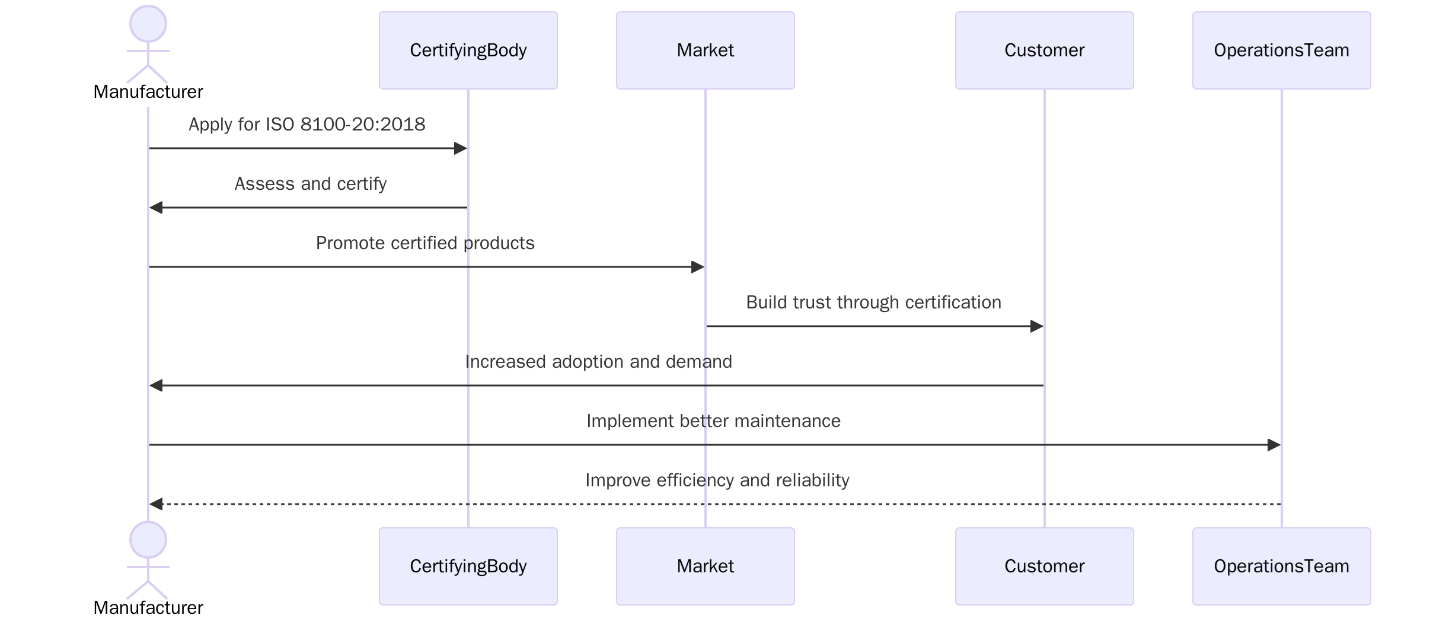
- Improved passenger safety through adherence to globally accepted lift design and operational requirements.
- Greater market acceptance as compliance with ISO standards is often a prerequisite for large-scale construction projects.
- Consistent ride quality with reduced vibration, accurate leveling, and noise control.
- Better accessibility for all users, including those with disabilities, through standardised design features.
- Reduced liability risks by ensuring lifts meet recognised safety and performance benchmarks.
- Increased asset value as certified lifts add credibility and appeal to property developments.
- Enhanced maintenance planning thanks to structured design and documentation standards.
Steady rise in the adoption of ISO 8100-20 certification, particularly in regions experiencing rapid urban development and high-rise construction. With increased demand for mixed-use buildings and modern commercial complexes, developers are prioritising lift systems that meet international safety, accessibility, and performance standards.
Eligibility Criteria
Any organization involved in the design, manufacture, installation, or modernization of lifts can apply for ISO 8100-20 certification. This includes lift component manufacturers, system integrators, and installation contractors. There are no restrictions based on company size or geographic location, but applicants must have documented product designs and lift models ready for inspection and testing. The lifts presented for certification must be intended for transporting both persons and goods in accordance with the standard’s defined scope.
Certification Process
Pacific Certifications follows a thorough process to ensure every lift model and installation meets ISO 8100-20 requirements. The process generally includes:
- Application and scope definition – Identification of the lift systems, models, or projects to be certified.
- Document review – Examination of technical drawings, component specifications, safety plans, and maintenance manuals.
- Pre-assessment (optional) – An early review to identify non-conformities before the main audit.
- Type testing – Physical inspection and performance testing of the lift, including safety system checks, ride quality assessment, and dimension verification.
- Stage 1 audit – Evaluation of documented processes for design, manufacturing, and installation.
- Stage 2 audit – On-site verification of lifts in operation to ensure conformity with the standard.
- Final evaluation – Review of test results, non-conformity reports, and corrective actions (if applicable).
- Certification issuance – Granting of ISO 8100-20 certification for the approved models or installations.
Timeline for ISO 8100-20:2018 Certification
The typical certification timeline ranges from six to eight weeks, depending on the number of lift models, project size, and availability of testing facilities. For manufacturers seeking certification for multiple designs, the process may take longer as each variant requires separate testing. Delays can occur if design modifications are needed following the initial review. Where a pre-assessment is conducted, this may shorten the overall timeline by addressing issues early.
What is the Cost for ISO 8100-20:2018 Certification?
Certification costs vary depending on factors such as the number of lift models submitted, the complexity of their design, and whether type testing is required for each unit. Costs can also be influenced by travel requirements for site audits, additional testing for specialised lift functions, or integration with other certifications like ISO 9001. Organizations with multiple sites or large-scale projects may benefit from combined audit arrangements to reduce costs.
How can Pacific Certifications Help?
Pacific Certifications provides end-to-end certification services for ISO 8100-20, assisting clients in preparing, testing, and validating their lifts for both passenger and goods transport. Our services include:
- Reviewing technical designs and safety features before submission.
- Coordinating type testing and ride performance assessments.
- Verifying compliance with accessibility and dimension criteria.
- Guiding on documentation, labeling, and user instructions.
- Conducting independent audits for manufacturing and installation sites.
By working with Pacific Certifications, you can ensure your lifts meet internationally recognised safety and performance benchmarks while maintaining high installation quality.
Training and Courses
Pacific Certifications offers training programs to help lift manufacturers, engineers, and safety inspectors understand and apply ISO 8100-20 requirements effectively:
- Lead Auditor Training – Designed for professionals tasked with auditing lift designs and installations for compliance.
- Lead Implementer Training – Suitable for engineering teams responsible for integrating ISO 8100-20 into design and production processes.
- Internal Auditor Training – Focused on in-house quality control and safety teams ensuring ongoing compliance during maintenance and upgrades.
Pacific Certifications provides accredited training programs. If your organization is looking for ISO 8100-20 training, our team is ready to help you. Contact us at support@pacificcert.com
Frequently Asked Questions (FAQs)
Is ISO 8100-20 certification mandatory for all lifts?
No, but it is highly recommended for lifts in new buildings or major modernization projects, especially where safety and performance documentation is required.
Can ISO 8100-20 be applied to goods-only lifts?
The standard is primarily for lifts that carry both persons and goods. Goods-only lifts fall under different standards.
Does certification cover maintenance practices?
The standard addresses design and installation, but maintenance practices should align with manufacturer instructions and local codes.
Are custom lift designs eligible for certification?
Yes, provided they meet the standard’s dimensional and safety requirements.
What documents are required for the audit?
Technical drawings, safety assessments, type test reports, and maintenance instructions are usually required.
How often should lifts be re-certified?
While the standard itself does not set a re-certification period, many projects require renewal every three to five years.
Can existing lifts be upgraded for compliance?
Yes, upgrades can be made to bring lifts in line with ISO 8100-20 requirements, though feasibility depends on the current installation.
Ready to get ISO 8100 certified?
Contact Pacific Certifications to begin your certification journey today!
Suggested Certifications –
Read more: Pacific Blogs
